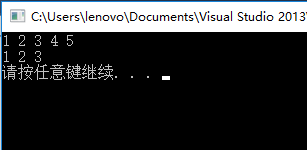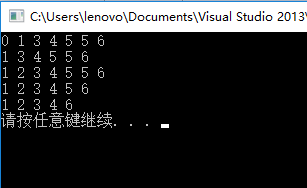版权声明:版权声明:本文为博主原创文章,未经博主允许不得转载。 https://blog.csdn.net/kevin980123 https://blog.csdn.net/kevin980123/article/details/83617611
顺序表相关操作
程序代码如下:
SeqList.h
#ifndef __SEQLIST_H__
#define __SEQLIST_H__
#include <stdio.h>
#include <assert.h>
#define MAX 10
typedef int DataType;
typedef struct SeqList
{
DataType data[MAX];
int sz;
}SeqList,*pSeqList;
//初始化
void InitSeqList(pSeqList pSeq);
//尾部插入
void PushBack(pSeqList pSeq, DataType data);
//尾部删除
void PopBack(pSeqList pSeq);
//头部插入
void PushFront(pSeqList pSeq, DataType data);
//头部删除
void PopFront(pSeqList pSeq);
//查找指定元素
int Find(pSeqList pSeq, DataType data);
//指定位置插入
void Insert(pSeqList pSeq, int pos, DataType data);
//删除指定位置元素
void Erase(pSeqList pSeq, int pos);
//删除指定元素
void Remove(pSeqList pSeq, DataType data);
//删除所有的指定元素
void RemoveAll(pSeqList pSeq, DataType data);
//返回顺序表的大小
int Size(pSeqList pSeq);
//判断顺序表是否为空
int Empty(pSeqList pSeq);
//冒泡排序
void BubbleSort(pSeqList pSeq);
//选择排序
void SelectSort(pSeqList pSeq);
//选择排序的优化
void SelectSortOP(pSeqList pSeq);
//二分查找
int BinarySearch(pSeqList pSeq, DataType data);
//二分查找递归写法
int BinarySearch_R(pSeqList pSeq, int left, int right, DataType d);
//打印
void PrintSeqList(pSeqList pSeq);
#endif //__SEQLIST_H__
SeqList.c
#include <string.h>
#include "SeqList.h"
//初始化
void InitSeqList(pSeqList pSeq)
{
assert(pSeq);
pSeq->sz = 0;
memset(pSeq->data, 0, sizeof(pSeq->data));
}
//尾部插入
void PushBack(pSeqList pSeq,DataType data)
{
assert(pSeq);
if (pSeq->sz == MAX)
{
printf("顺序表已满,无法插入\n");
return;
}
pSeq->data[pSeq->sz] = data;
pSeq->sz++;
}
//尾部删除
void PopBack(pSeqList pSeq)
{
assert(pSeq);
if (pSeq->sz == 0)
{
return;
}
pSeq->sz--;
}
//头部插入
void PushFront(pSeqList pSeq, DataType data)
{
assert(pSeq);
int i = 0;
if (pSeq->sz == MAX)
{
printf("顺序表已满,无法插入\n");
return;
}
for (i = pSeq->sz; i > 0; i--)
{
pSeq->data[i] = pSeq->data[i - 1];
}
pSeq->data[0] = data;
pSeq->sz++;
}
//头部删除
void PopFront(pSeqList pSeq)
{
assert(pSeq);
if (pSeq->sz)
{
int i = 0;
for (i = 0; i < pSeq->sz - 1; i++)
{
pSeq->data[i] = pSeq->data[i + 1];
}
pSeq->sz--;
}
}
//查找指定元素
int Find(pSeqList pSeq, DataType data)
{
assert(pSeq);
int i = 0;
for (i = 0; i < pSeq->sz; i++)
{
if (data == pSeq->data[i])
return i;
}
return -1;
}
//指定位置插入
void Insert(pSeqList pSeq, int pos, DataType data)
{
assert(pSeq);
int i = 0;
if (pSeq->sz == MAX)
return;
for (i = pSeq->sz; i > pos; i--)
{
pSeq->data[i] = pSeq->data[i - 1];
}
pSeq->data[pos] = data;
pSeq->sz++;
}
//删除指定位置元素
void Erase(pSeqList pSeq, int pos)
{
assert(pSeq);
int i = 0;
if (pSeq->sz == 0)
return;
for (i = pos; i < pSeq->sz - 1; i++)
{
pSeq->data[i] = pSeq->data[i + 1];
}
pSeq->sz--;
}
//删除指定元素
void Remove(pSeqList pSeq, DataType data)
{
assert(pSeq);
int i = 0;
int pos = 0;
if (pSeq->sz == 0)
return;
while ((pos = Find(pSeq, data)) != -1)
{
for (i = pos; i < pSeq->sz - 1; i++)
{
pSeq->data[i] = pSeq->data[i + 1];
}
pSeq->sz--;
}
}
//删除所有的指定元素
void RemoveAll(pSeqList pSeq, DataType data)
{
assert(pSeq);
int i = 0;
int j = 0;
if (pSeq->sz == 0)
return;
while (i < pSeq->sz)
{
if (pSeq->data[i] != data)
{
if (i != j)
pSeq->data[j] = pSeq->data[i];
i++;
j++;
}
else
{
i++;
}
}
pSeq->sz = j;
}
//返回顺序表的大小
int Size(pSeqList pSeq)
{
assert(pSeq);
return pSeq->sz;
}
//判断顺序表是否为空
int Empty(pSeqList pSeq)
{
assert(pSeq);
return 0 == pSeq->sz;
}
//冒泡排序
void BubbleSort(pSeqList pSeq)
{
assert(pSeq);
int i = 0;
int j = 0;
DataType tmp = 0;
if (pSeq->sz == 0)
return;
for (i = 0; i < pSeq->sz - 1; i++)
{
for (j = 0; j < pSeq->sz - 1 - i; j++)
{
if (pSeq->data[j] > pSeq->data[j + 1])
{
tmp= pSeq->data[j];
pSeq->data[j] = pSeq->data[j + 1];
pSeq->data[j + 1] = tmp;
}
}
}
}
//选择排序
void SelectSort(pSeqList pSeq)
{
assert(pSeq);
int i = 0;
int j = 0;
DataType tmp = 0;
if (pSeq->sz == 0)
return;
for (i = 0; i < pSeq->sz - 1; i++)
{
for (j = i + 1; j < pSeq->sz - 1; j++)
{
if (pSeq->data[i] > pSeq->data[j])
{
tmp = pSeq->data[i];
pSeq->data[i] = pSeq->data[j];
pSeq->data[j] = tmp;
}
}
}
}
//选择排序的优化
void SelectSortOP(pSeqList pSeq)
{
assert(pSeq);
int i = 0;
int j = 0;
int index = 0;
DataType num = 0;
DataType tmp = 0;
if (pSeq->sz == 0)
return;
for (i = 0; i < pSeq->sz - 1; i++)
{
index = i;
num = pSeq->data[i];
for (j = i + 1; j < pSeq->sz - 1; j++)
{
if (num > pSeq->data[j])
{
index = j;
num = pSeq->data[j];
}
}
if (index != i)
{
tmp = pSeq->data[index];
pSeq->data[index] = pSeq->data[i];
pSeq->data[i] = tmp;
}
}
}
//二分查找
int BinarySearch(pSeqList pSeq, DataType data)
{
assert(pSeq);
int left = 0;
int right = pSeq->sz - 1;
while (left <= right)
{
int mid = left + ((right - left) >> 1);
if (data < pSeq->data[mid])
right = mid - 1;
else if (data == pSeq->data[mid])
return mid;
else
left = mid + 1;
}
return -1;
}
//二分查找递归写法
int BinarySearch_R(pSeqList pSeq, int left, int right, DataType d)
{
assert(pSeq);
if (left <= right)
{
int mid = left + ((right - left) >> 1);
if (d == pSeq->data[mid])
return mid;
else if (d < pSeq->data[mid])
return BinarySearch_R(pSeq, left, mid - 1, d);
else
return BinarySearch_R(pSeq, mid + 1, right, d);
}
return -1;
}
//打印
void PrintSeqList(pSeqList pSeq)
{
assert(pSeq);
int i = 0;
if (pSeq->sz == 0)
{
printf("顺序表为空\n");
return;
}
for (i = 0; i < pSeq->sz; i++)
{
printf("%d ", pSeq->data[i]);
}
printf("\n");
}
test.c
#include <stdio.h>
#include "SeqList.h"
#define SORT 0
#define BS 2
void test1()
{
SeqList ps;
//初始化
InitSeqList(&ps);
//尾部插入
PushBack(&ps, 1);
PushBack(&ps, 2);
PushBack(&ps, 3);
PushBack(&ps, 4);
PushBack(&ps, 5);
//打印
PrintSeqList(&ps);
//尾部删除
PopBack(&ps);
PopBack(&ps);
//打印
PrintSeqList(&ps);
}
void test2()
{
SeqList ps;
//初始化
InitSeqList(&ps);
//头部插入
PushFront(&ps, 6);
PushFront(&ps, 5);
PushFront(&ps, 5);
PushFront(&ps, 4);
PushFront(&ps, 3);
PushFront(&ps, 1);
PushFront(&ps, 0);
//打印
PrintSeqList(&ps);
//头部删除
PopFront(&ps);
//打印
PrintSeqList(&ps);
//查找指定元素
int num = Find(&ps, 3);
if (num !=-1)
//指定位置插入
Insert(&ps, num, 2);
//打印
PrintSeqList(&ps);
//查找指定元素
num = Find(&ps, 5);
//删除指定位置元素
Erase(&ps, num);
//打印
PrintSeqList(&ps);
//删除指定元素
Remove(&ps, 5);
//打印
PrintSeqList(&ps);
}
void test3()
{
SeqList ps;
//初始化
InitSeqList(&ps);
//头部插入
PushFront(&ps, 9);
PushFront(&ps, 7);
PushFront(&ps, 11);
PushFront(&ps, 6);
PushFront(&ps, 2);
PushFront(&ps, 8);
PushFront(&ps, 11);
//打印
PrintSeqList(&ps);
//删除所有的指定元素
RemoveAll(&ps, 11);
//打印
PrintSeqList(&ps);
//返回顺序表的大小
int sz = Size(&ps);
printf("顺序表大小:%d\n", sz);
//判断顺序表是否为空
int ret = Empty(&ps);
if (0 == ret)
printf("顺序表不为空\n");
else
printf("顺序表为空\n");
switch (SORT)
{
case 1:
//选择排序
SelectSort(&ps);
break;
case 2:
//选择排序的优化
SelectSortOP(&ps);
break;
default:
//冒泡排序
BubbleSort(&ps);
break;
}
//打印
PrintSeqList(&ps);
if (1 == BS)
{
//二分查找
ret = BinarySearch(&ps, 7);
if (ret == -1)
printf("找不到该元素\n");
else
printf("该元素位于顺序表第%d位\n",ret);
}
else
{
//二分查找递归写法
ret = BinarySearch_R(&ps, 0, ps.sz - 1, 12);
if (ret == -1)
printf("找不到该元素\n");
else
printf("该元素位于顺序表第%d位\n", ret);
}
}
int main()
{
//test1();
//test2();
test3();
system("pause");
return 0;
}
程序运行结果如下:
test1();

test2();

test3();
